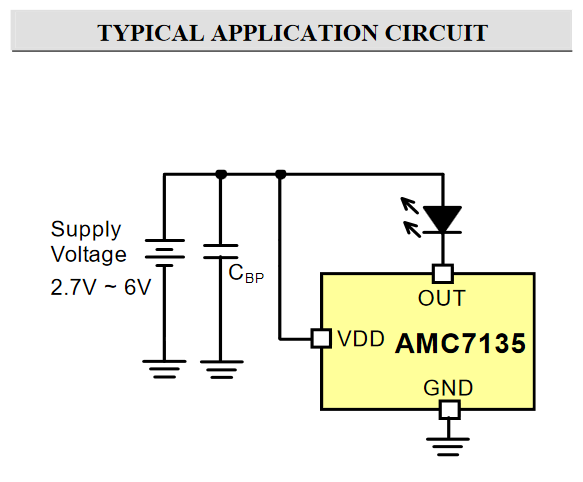AMC7135 1W LED Driver Schematic
The AMC7135 current sink can drive a 1W LED with very little additional circuitry. All you need is decoupling and the LED itself. You might need an external dropper resistor in some cases to distribute the heat dissipated by the circuit if the source voltage is higher than the maximum voltage allowed for AMC7135.
Here is the “typical” AMC7135 schematic used with a 1W or 350mA single LED. This is the circuit you will find in most devices like low cost flashlights and other such equipment.

The Problem with AMC7135 Circuits
There are a bunch of problems that come with using the low cost and simple AMC7135 constant current sink. You cannot get around those, and they can sometimes really hurt your application.
Heat Dissipation
Heat Dissipation can be a major problem with this chip. For example, if you are powering an LED with 350mA current, and the LED draws that current at 3.2V across the LED, this means that the AMC7135 is burning almost (0.35A * 1.8V) = 0.63W when powered from a 5V source!
If you burn 0.6W to light up an LED that is 1W, you are getting down to only 60% efficiency without even taking into account tons of other factors that cause energy to be wasted. There is no way to work around this as the AMC7135 is a linear current sink.
Low Efficiency and Battery Life
As mentioned above, the AMC7135 wastes a lot of energy by dropping it across the chip and therefore the efficiency is only about 60% in most cases.
No PWM or Brightness Control
There is no proper way to use PWM with this AMC7135. Granted you might not always need dimming in 1W applications, but even if you had dimming with this regulator, the efficiency will still be very low and the light would flicker after a certain PWM frequency.
Replace AMC7135?

Please fill in the Subscription Form in the sidebar so we can keep you updated with our latest articles.
We only mail you less than 2 times a month.
Change Log
- Initial Release: 15 May 2021
References
- Reference 1: AMC7135 and PWM, notes
- Reference 2: AMC7135 Datasheet
- Reference 3: ZXSC400 Datasheet
1 comment
While the base idear is certainly a good one, the choosen chip serves a different function, since the AMC drives LEDs at a lower than source voltage and the zxsc drives led at higher than source voltage.
With a 5V supply, this mandates that the amc only drives 1 led, while the zxsc drives a minimum of 2 leds. (The amc can controll an led string of up to 24v before the internal protection triggers, the vin still has to be under 6v ).
A closer replacement would be the PAM2804 as a stepdown with the same voltage range as the amc or a PAM2804 if a step up is needed to drive a single led.